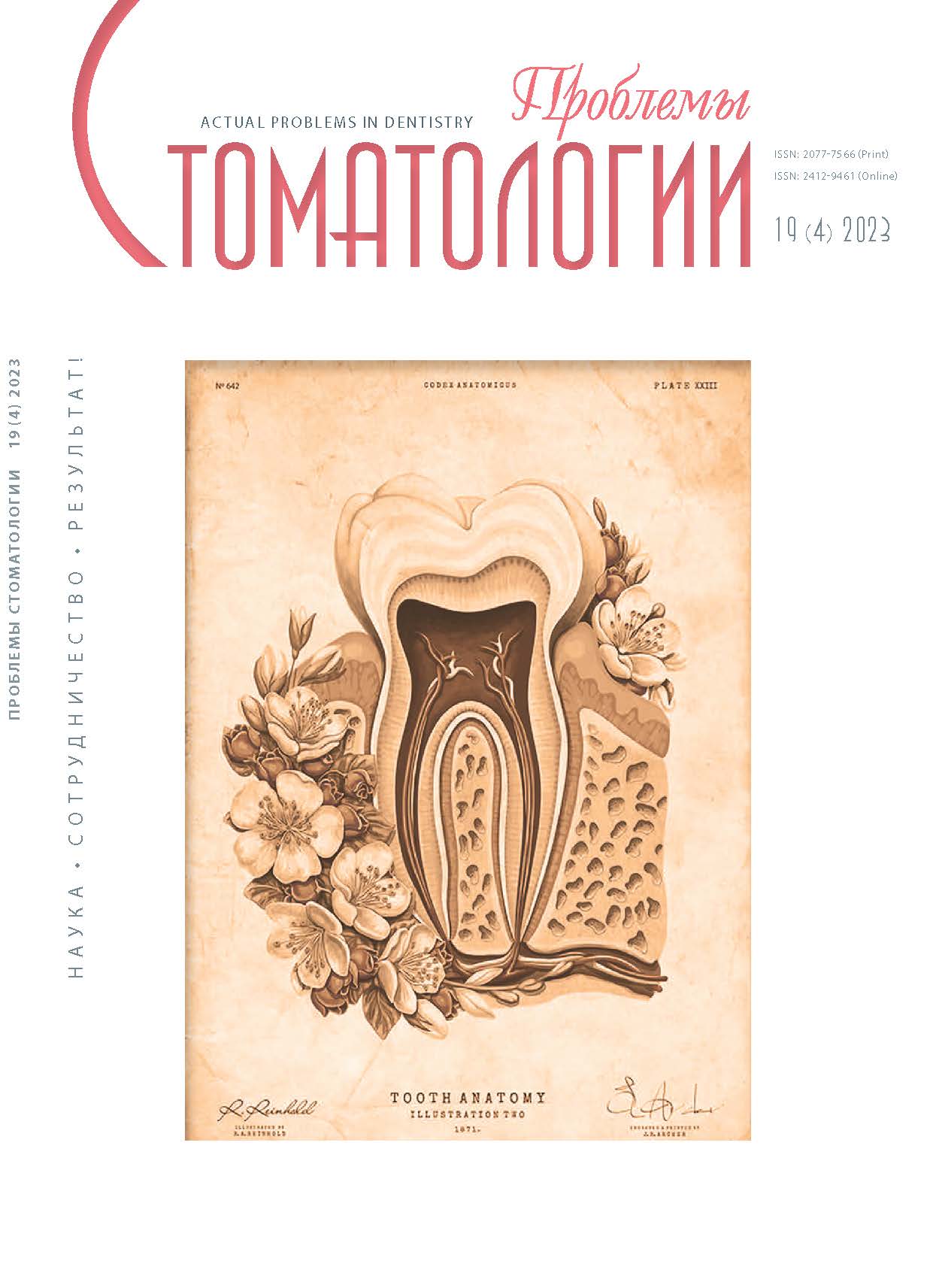LLC SK UniDent (chief physician and director)
Kazan, Kazan, Russian Federation
Kazan, Kazan, Russian Federation
Yekaterinburg, Kazan, Russian Federation
UDC 616.31
Introduction. This article is devoted to the study of the prevalence of dental diseases in preschool children living in incomplete and extended families. In the course of the study, children from both types of families were examined for dental caries and its complications, for non-caries dental diseases. While studying periodontal diseases, were distinguished inflammatory diseases, such as catarrhal and hypertrophic gingivitis, as well as localized periodontitis, when studying diseases of the oral mucosa, we highlighted diseases of the lips, tongue and oral mucosa. When studying dentoalveolarabnomalies, we identified both abnormalities of bite, dental arches and rows, and individual teeth. The subject of research is dental diseases in preschool children. The goal of the study is to analyze dental morbidity in children from extended and incomplete families. Methodology. The study was conducted on the basis of the UniDent network of dental clinics, as well as in the Fairy Tale preschool commercial institution in Kazan and municipal preschool institutions of Tatarstan Republic. A total of 222 children from 217 incomplete families and 213 children from 199 extended families of both sexes participated in the voluntary study. Examination of children included examining the child and talking with parents or guardians, filling out medical records, determining the type of family, filling out an individual card in which identified dental diseases were recorded. The results of the study indicate a high prevalence of dental diseases among preschool children in TR. The progression of dental diseases is observed with the age of the child. Children from incomplete families are more susceptible to the occurrence and development of dental diseases, compared with children from extended families. Conclusions. The findings on the disparate prevalence of dental diseases in children from incomplete and extended families suggest the presence of family type influences, which may be useful in planning prevention methods and predicting dental outcomes in children from different family types.
preschool children, dental diseases, dental abnormalities, tooth decay and its complications, non-carious dental diseases, mucosal diseases, periodontal diseases, extended family, incomplete family
1. Alkhtib A. Knowledge, Attitudes, and Practices of Mothers of Preschool Children About Oral Health in Qatar: A Cross-Sectional Survey // Dent. J. - 2018;6.4:51. doi:https://doi.org/10.3390/dj6040051.
2. Kirthiga M., Murugan M., Saikia A., Kirubakaran R. Factors for Early Childhood Caries: A Systematic Review and Meta-Analysis of Case Control and Cohort Studies // Pediatr. Dent. - 2019;41(2):95. https://pubmed.ncbi.nlm.nih.gov/30992106/
3. Xiao J., Alkhers N., Kopycka-Kedzierawski D.T. et al. Prenatal Oral Health Care and Childhood Caries Prevention: A Systematic Rewiew and Meta-Analysis // Caries Res. - 2019;10,1-11. doihttps://doi.org/10.1159/000495187
4. Alshunaiber A., Alzaid H., Meaigel S. et al. Early childhood caries and infant' soral health; pediatricians' and family physicians' practice, knowledge and attitude in Riyadhcity, Saudi Arabia // SaudiDent. J. - 2019;96-105. doihttps://doi.org/10.1016/j.sdentj.2019.01.006
5. Olesov E.E., Kaganova O.S., Mirgazizov M.Z., Olesova V.N., Fazylova T.A. Rezul'tativnost' ustraneniya zubochelyustnyh anomaliy u detey mladshego shkol'nogo vozrast. Medicina ekstremal'nyh situaciy. 2020;2:170-173. [E.E. Olesov, O.S. Kaganova, M.Z. Mirgazizov, V.N. Olesova, T.A. Fazylova. Effectivenessofelimination of jugular anomaliesin primary school children. Medicine of extreme situations. 2020;2:170-173.(In Russ.)]. https://cyberleninka.ru/article/n/rezultativnost-ustraneniya-zubochelyustnyh-anomaliy-u-detey-mladshego-shkolnogo-vozrasta
6. Hadyeva M.N., Galiullin A.N., Saleev R.A., Ginniatullin I.I., Zaripova E.R. Sovremennye voprosy detskoy stomatologii v usloviyah realizacii nacional'noy programmy «Zdravoohranenie i Demografiya». Kazan'. 2021:163. [M.N. Khadyeva, A.N. Galiullin, R.A. Saleev, E.M. Zaripova, I.I. Giniyatullin, Zaripova E.R. Modern issues of pediatric dentist ryin the context of the implementation of the national program "Health" and "Demography" Kazan. 2021:163.(In Russ.)]. https://repository.kpfu.ru/eng/?p_id=283589&p_lang=2
7. Novoselova E.N. Rol' sem'i v formirovanii zdorovogo obraza zhizni i smyagchenii faktorov riska, ugrozhayuschih zdorov'yu detey i podrostkov. Analiz riska zdorov'yu. 2019(4):175-185. [E.N. Novoselova. The role of the family in shaping healthy lifestyles and mitigating risk factors that threaten the health of children and adolescents. Health risk analysis. 2019(4):175-185. (In Russ.)]. https://journal.fcrisk.ru/2019/4/19
8. Pikuza O.I., Suleymanova Z.Ya., Zakirova A.M. Rol' sem'i v formirovanii zdorov'ya rebenka. Prakticheskaya medicina. 2019;17(5):161-164. [O.I. Pikuza, Z.Ya. Sulejmanova, A.M. Zakirova. Family role in the kid’s health development. Practitional medicine. 2019;17(5):161-164. (In Russ.)]. https://cyberleninka.ru/article/n/rol-semi-v-formirovanii-zdorovya-rebenka-1
9. Vinichenko S.N., Perevoschikova N.A., Drakina S.A., Chernyh N.S. Rol' sem'i v formirovanii zdorovogo obraza zhizni detey doshkol'nogo vozrasta. Mat' i ditya v Kuzbasse. 2017;4(71):20-25. [S.N. Vinichenko, N.A. Perevoshchikova, S.A. Drakina, N.S. Chernyh. The role of the family in shaping a healthy lifestyle for preschool children. Mother and child in Kuzbass 2017;4(71):20-25. (In Russ.)]. https://cyberleninka.ru/article/n/rol-semi-v-formirovanii-zdorovogo-obraza-zhizni-detey-doshkolnom-vozraste
10. Voronin G.L., Yanak A.L. Monoroditel'skie sem'i: ih tipy i social'nyy portret odinokogo roditelya. Zhenschina v rossiyskom obschestve. 2018;1(86).53-66. [G.L. Voronin, A.L. Yanak. Mono-parent families: their types and social portrait of a single parent. Woman in Russian society. 2018;1(86):53-66. (In Russ.)]. https://cyberleninka.ru/article/n/monoroditelskie-semi-ih-tipy-i-sotsialnyy-portret-odinokogo-roditelya



















